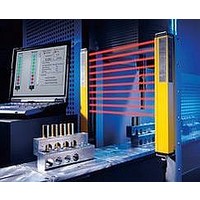F39-EU1E Omron, F39-EU1E Datasheet - Page 191

F39-EU1E
Manufacturer Part Number
F39-EU1E
Description
F3S-B OPTIONAL PROGRAMMING KIT
Manufacturer
Omron
Datasheet
1.F39-EU1E.pdf
(865 pages)
Specifications of F39-EU1E
Leaded Process Compatible
No
Peak Reflow Compatible (260 C)
No
Light Curtain Type
Safety
Lead Free Status / RoHS Status
Contains lead / RoHS non-compliant
Lead Free Status / RoHS Status
Contains lead / RoHS non-compliant
- Current page: 191 of 865
- Download datasheet (35Mb)
Courtesy of Steven Engineering, Inc.-230 Ryan Way, South San Francisco, CA 94080-6370-Main Office: (650) 588-9200-Outside Local Area: (800) 258-9200-www.stevenengineering.com
Wiring of Inputs and Outputs
Power supply input A1, A2
Safety input A,
channel 1
Safety input A,
channel 2
Safety input B,
channel 1
Safety input B,
channel 2
Feedback/reset
input
Logical AND
connection input
Mode selector input M1, M2
Cross fault
detection inputs
External indicator
diagnosis switching
inputs
Signal name
http://www.ia.omron.com/
T11, T12
T21, T22
T61, T62
T71, T72
T31, T32, T33
T41, T42
Y1, Y2
Y3, Y4
Terminal
name
The power supply input terminals for the G9SX-GS@.
Connect the power source to the A1 and A2 terminals.
Using Auto Switching:
For the safety output to go to the ON state, both
channels 1 and 2 of safety input A must be in the ON
state, channels 1 and 2 of safety input B must be in the
ON state.
Using Manual Switching:
For the safety output to go to the ON state when safety
input A is activated, both channels 1 and 2 of safety
input A must be in the ON state (for maintenance
mode).
For the safety output to go to the ON state when safety
input B is activated, both channels 1 and 2 of safety
input B must be in the ON state (for normal operating
mode).
For the safety output to go to the ON state, the ON state
signal must be input to T33.
Otherwise the safety outputs cannot be in the ON state.
For the safety output to go to the ON state, the signal
input to T32 must change from the OFF state to the ON
state, and then to the OFF state. Otherwise the safety
outputs cannot be in the ON state.
A logical AND connection means that one Unit (Unit A)
outputs a safety signal “a” to a subsequent Unit (Unit B)
and Unit B calculates the logical AND of “a” and safety
signal “b.” In the example shown at the right, the logical
AND connection results in a safety output of “a AND b”
for Unit B.
Connect L1 of Unit A and T41 of Unit B to the power
supply negative terminal (GND) of Unit A and T42 of
Unit B.
For the safety output to go to the ON state in the
subsequent Unit, its logical AND connection preset
switch must be set to AND (enabled) and the HIGH
state signal must be input to T41 of the subsequent
Unit.
When manual switching is selected, the SPST-NO/
SPST-NC input enables the input of either safety input
A or safety input B. The relationship of the safety input
enable state and the mode selector input is as follows:
M1 = ON, M2 = OFF: Safety input B is enabled (normal
operating mode)
M1 = OFF, M2 = ON: Safety input A is enabled
(maintenance mode)
Selects the mode for the failure detecting (cross fault
detecting) function for the safety inputs of G9SX-GS@
corresponding to the connection of the cross fault
detection input.
Enables or disables error detection for the external
indicator outputs of the G9SX-GS@.
Description of operation
(c)Copyright OMRON Corporation 2007 All Rights Reserved.
Connect the power supply plus (24 VDC) to the
A1 terminal.
Connect the power supply minus (GND) to the A2
terminal.
Corresponds to
Safety Category
2
Corresponds to
Safety Category
3
Corresponds to
Safety Category
4
Corresponds to
Safety Category
2
Corresponds to
Safety Category
3
Corresponds to
Safety Category
4
Auto reset
Manual reset
Keep the circuits open when using auto
switching.
Keep Y1 open when using T11 and T21 (wiring to
enable cross fault detection).
Keep Y2 open when using T61 and T71 (wiring to
enable cross fault detection).
Connect Y1 to 24 VDC when not using T11 and
T21 (wiring to disable cross fault detection, or
when connecting safety sensors).
Connect Y2 to 24 VDC when not using T61 and
T71 (wiring to disable cross fault detection, or
when connecting safety sensors).
Keep Y3 open when detecting errors for UA.
Keep Y4 open when detecting errors for UB.
Connect Y3 to 24 VDC when not detecting errors
for UA.
Connect Y4 to 24 VDC when not detecting errors
for UB.
Output (a AND b)
Unit A
Unit B
Output (a)
Next unit (5 layers max.)
G9SX-GS@
T41 T42
T41 T42
G9SX-GS@
G9SX-GS@
Safety input A
L1 A2
L1
L1
is enabled
+24 V
A2
A2
Logical AND connection sig. (1st layer)
Logical AND connection sig. (2nd layer)
M1
Input a
Input b
M2
Mode
selector
Wiring
Switch
Reset
v
Safety input B
is enabled
T31
T31
+24 V
T11 T12 T21 T22
T61 T62 T71 T72
M1
T11 T12 T21 T22
T11 T12 T21 T22
T61 T62 T71 T72
T61 T62 T71 T72
G9SX-GS
+24 V
T32
T32
+24 V
+24 V
+24 V
+24 V
M2
T41 T42
Feedback loop
KM +24 V
G9SX-GS@
Next unit (4 units max.)
Next unit (4 units max.)
Mode
selector
Not connected
Not connected
T33
T33
+24 V
+24 V
KM
Y1
Y2
Feedback loop
Y1
Y2
Y2
Y1
+24 V
+24 V
+24 V
+24 V
9
Related parts for F39-EU1E
Image
Part Number
Description
Manufacturer
Datasheet
Request
R

Part Number:
Description:
Pair Of Flat Mounting Brackets (transmitter & Receiver)
Manufacturer:
Omron

Part Number:
Description:
Pair Of Protective Shrouds (transmitter & Receiver)
Manufacturer:
Omron

Part Number:
Description:
G6S-2GLow Signal Relay
Manufacturer:
Omron Corporation
Datasheet:

Part Number:
Description:
Compact, Low-cost, SSR Switching 5 to 20 A
Manufacturer:
Omron Corporation
Datasheet:

Part Number:
Description:
Manufacturer:
Omron Corporation
Datasheet:










